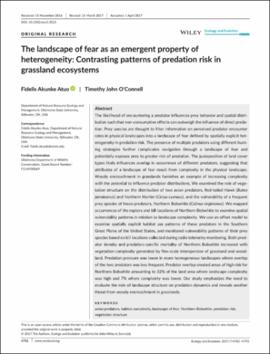| dc.contributor.author | Atuo, Fidelis A. | |
| dc.contributor.author | O'Connell, Timothy J. | |
| dc.date.accessioned | 2019-08-22T17:51:02Z | |
| dc.date.available | 2019-08-22T17:51:02Z | |
| dc.date.issued | 2017-05-24 | |
| dc.identifier | oksd_atuo_thelandscapeoff_2017-05-24 | |
| dc.identifier.citation | Atuo, F. A., & O'Connell, T. J. (2017). The landscape of fear as an emergent property of heterogeneity: Contrasting patterns of predation risk in grassland ecosystems. Ecology and Evolution, 7(13), 4782-4793. https://doi.org/10.1002/ece3.3021 | |
| dc.identifier.uri | https://hdl.handle.net/11244/321263 | |
| dc.description.abstract | The likelihood of encountering a predator influences prey behavior and spatial distribution such that non-consumptive effects can outweigh the influence of direct predation. Prey species are thought to filter information on perceived predator encounter rates in physical landscapes into a landscape of fear defined by spatially explicit heterogeneity in predation risk. The presence of multiple predators using different hunting strategies further complicates navigation through a landscape of fear and potentially exposes prey to greater risk of predation. The juxtaposition of land cover types likely influences overlap in occurrence of different predators, suggesting that attributes of a landscape of fear result from complexity in the physical landscape. Woody encroachment in grasslands furnishes an example of increasing complexity with the potential to influence predator distributions. We examined the role of vegetation structure on the distribution of two avian predators, Red-tailed Hawk (Buteo jamaicensis) and Northern Harrier (Circus cyaneus), and the vulnerability of a frequent prey species of those predators, Northern Bobwhite (Colinus virginianus). We mapped occurrences of the raptors and kill locations of Northern Bobwhite to examine spatial vulnerability patterns in relation to landscape complexity. We use an offset model to examine spatially explicit habitat use patterns of these predators in the Southern Great Plains of the United States, and monitored vulnerability patterns of their prey species based on kill locations collected during radio telemetry monitoring. Both predator density and predation-specific mortality of Northern Bobwhite increased with vegetation complexity generated by fine-scale interspersion of grassland and woodland. Predation pressure was lower in more homogeneous landscapes where overlap of the two predators was less frequent. Predator overlap created areas of high risk for Northern Bobwhite amounting to 32% of the land area where landscape complexity was high and 7% where complexity was lower. Our study emphasizes the need to evaluate the role of landscape structure on predation dynamics and reveals another threat from woody encroachment in grasslands. | |
| dc.format | application/pdf | |
| dc.language | en_US | |
| dc.publisher | Wiley Open Access | |
| dc.rights | This material has been previously published. In the Oklahoma State University Library's institutional repository this version is made available through the open access principles and the terms of agreement/consent between the author(s) and the publisher. The permission policy on the use, reproduction or distribution of the material falls under fair use for educational, scholarship, and research purposes. Contact Digital Resources and Discovery Services at lib-dls@okstate.edu or 405-744-9161 for further information. | |
| dc.title | Landscape of fear as an emergent property of heterogeneity: Contrasting patterns of predation risk in grassland ecosystems | |
| osu.filename | oksd_atuo_thelandscapeoff_2017-05-24.pdf | |
| dc.description.peerreview | Peer reviewed | |
| dc.identifier.doi | 10.1002/ece3.3021 | |
| dc.description.department | Natural Resource Ecology and Management | |
| dc.type.genre | Article | |
| dc.type.material | Text | |
| dc.subject.keywords | northern bobwhite | |
| dc.subject.keywords | avian predators | |
| dc.subject.keywords | habitat complexity | |
| dc.subject.keywords | landscape of fear | |
| dc.subject.keywords | predation risk | |
| dc.subject.keywords | vegetation structure | |
